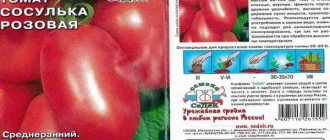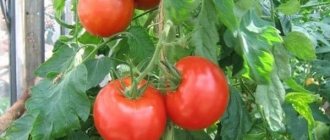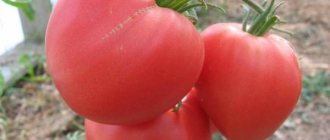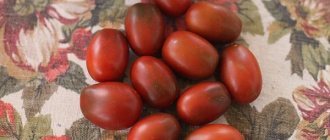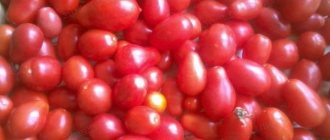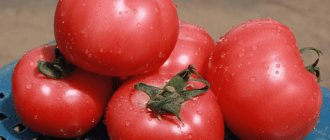Orange tomatoes are always relevant - they have a unique sweet taste and a sunny, festive look. Thanks to its incredibly delicate texture and fruity notes, the amber heart of F1 is a favorite among gardeners. It has an excellently balanced formula of valuable elements - from carotene to lycopene.
| Height | Landing location | Ripening time | Fruit color | Fruit size | Origin | Fruit shape |
| Medium height | Greenhouse, Open ground | Ultra early | Orange | Average | Hybrid | Heart-shaped |
Getting to know the variety
We say “Bull's Heart” and imagine a huge red fleshy tomato. This is the main feature of the variety - the weight of tomatoes is up to 900 grams. Let's expand our understanding of the Bull's Heart tomato: consider the description of what nature has provided, how to grow a healthy plant, and in what form to use the crop.
Characteristics of the variety
Breeders of Agrofirma Poisk LLC strengthened the characteristics, gave a detailed description of the Bull Heart variety, and in 2003 it was included in the State Register of Breeding Achievements recommended for the territory of the Russian Federation.
Experts recommend Bull's Heart for greenhouses and greenhouses, except in the southern regions, where the variety is productive in open areas. The natural qualities of the original variety include strong immunity against viruses, infections and insects.
The characteristics of the variety say that the fruiting process begins after 130 days. In the description of the characteristics of the harvest, we find that on the first clusters the fruits have time to ripen, the remaining tomatoes are picked in a blanched state of ripeness.
The variety's characteristics indicate average immunity to disease; the highest danger is described as late blight.
These tomatoes have good performance during long-term transportation; they retain freshness and taste within 95%.
The original variety has many hybrid forms, which necessarily retain the main characteristic - a large tomato.
Brief description of the Bull's Heart variety hybrids:
- “Bull's heart orange” (mid-season, up to 1.6 m, fruits 300-400 g);
- “Bull’s heart pink” (mid-season, up to 1.5 m, fruits 100-400 g, greenhouse/ground);
- “Bull’s heart red” (mid-season, up to 1.7 m, fruits 150-500 g, greenhouse/ground);
- “Bull’s heart black” (mid-season, up to 1.7 m, fruits 500-600 g, greenhouses/ground);
- "Bull's heart white" (late-ripening, rich burgundy color).
A significant difference in the description of the characteristics of the hybrids was noted only in the color of the fruits. There is a slight difference in the height of the plants and the weight of the tomatoes.
Description of tomato bushes
Bull's heart tomatoes ripen on indeterminate, non-standard plants. They are powerful, spreading, with a crown with a small number of medium-sized leaves.
The length of the main stem reaches two meters in protected ground, and in open ridges it is slightly lower. In both cases, tomatoes need support. It is recommended to form the bushes into two stems. The tomato finishes growing when 5-6 clusters with fruits are formed.
The expected inflorescence emerges after the ninth leaf, each subsequent one after two leaves. One brush can produce up to 5-6 tomatoes.
Reproduction of Ox's heart by seedlings. The material can be purchased seeds or prepared from your own tomatoes.
Description and distinctive characteristics of the fruit
Weight
An important characteristic of the variety is tomatoes of various shapes and weights per plant. Large fruits up to 500-800 g ripen on the first clusters, all subsequent ones reach a size of 100-150 g
Experienced gardeners produced record tomatoes weighing up to 1 kg.
Form. The tomatoes are recognizable by their melting heart-shaped shape, which gives the variety its name. The ribbing is weakly expressed.
Color and content. The color of tomatoes depends on the type; the original variety produces bright red tomatoes. Hybrids can be grown in yellow-orange, pink, and black colors. A thin peel covers the pulp. It is fleshy, dense and low-water without veins. A tomato has up to five small chambers that contain a small number of seeds.
Taste and nutrients. The increased sugar content makes the pulp sweet. Fragrant tomatoes are nutritious and suitable for diets. They are rich in fiber and vitamins, acids and other minerals.
Storage. Ox heart retains its characteristics in a cool room for up to two weeks. Next, they need to be processed so that the beneficial qualities and taste are not lost.
Productivity and use of tomatoes
According to its varietal characteristics, bovine heart is a productive species. With proper agricultural technology, one bush produces up to five kilograms of tomatoes in open beds, and up to twelve kilograms in a greenhouse.
Tomatoes of this variety are harvested as they ripen throughout the summer and early autumn. If the climate allows and the weather conditions are favorable, then fruiting will continue throughout September.
The description of the fruit suggests that the Oxheart tomato corresponds to the salad group. In the summer, it is usually consumed fresh in various vitamin salads. Tomatoes are also tasty when heat treated in soup dressings, sauces, pastes, and ketchups.
Canning tomatoes is only possible “sliced”. There are many recipes for pickling, pickles and salads from Ox heart.
Features of cultivation
In order for the harvest to be good, you will need to follow several tips.
Preparatory activities
Sow Lionheart seeds in late March-early April. To do this you will need the following materials and tools:
- Capacity. Use a container with a depth of 5-7 cm. For the first picking, a pot of 10-15 cm is suitable, and for the second, the height of the container will be 20-30 cm.
- Priming. Purchase a ready-made substrate for tomatoes in a specialized store. Before using it, disinfect it by heating it in the oven to 100 degrees.
- Planting material. They can be sown without preparation, or first kept for 15-20 minutes in a bright pink solution of potassium permanganate, and then rinsed with water.
Planting seedlings
Procedure:
- Pour the substrate into containers so that there is a 2-3 cm border to the top. Water the soil.
- Place planting material on top, maintaining a distance of 2x2 cm.
- Sprinkle with a thin layer of earth (1 cm) and tamp down a little.
- Cover the container with glass and place in a warm place.
Growing seedlings
When 3-7 days have passed since sowing, the first shoots will appear. From now on, caring for seedlings involves observing the following actions:
- Remove the covering material and move the container to a bright place.
- Water the seedlings with warm and settled water as the soil dries out. During the first moisturizing, add potassium permanganate to the water until it turns pink. This is an excellent prevention against blackleg.
- 7 days after germination, when 1-2 leaves appear, pick, transplanting the plants into larger boxes and following a 5x5 cm pattern.
- If the plants are too elongated, then deepen them to the cotyledon leaves.
- As soon as the bushes in the container begin to touch each other with their leaves, and their above-ground part in volume exceeds the size of the earthen lump in the pot, then this is the time for the second picking. By this period, warm weather has set in, so the seedlings can be placed on a glassed-in balcony, in a greenhouse.
- During the entire period of growing seedlings, fertilize 3-4 times with an interval of 10-14 days. Use complex formulations, for example, Fertika Lux. To prepare the solution, take 20 g of the drug and 10 liters of water. After picking, carry out the first feeding no earlier than 7 days later.
Planting in open ground
Carry out planting work in open ground only after the threat of frost has passed. Most often this happens after June 5-7.
Procedure:
- The place should be thoroughly illuminated by sunlight, and there should be no trees or shrubs nearby.
- Sprinkle a nutrient composition prepared from 10 kg of humus and 500 g of wood ash over the area. This is enough for 1 m2. You can use finished products: Sudarushka, Gumi-Omi, Agricola.
- Dig up and level the soil surface.
- Arrange the bushes according to a 40x50 cm pattern, tie each one to a peg.
- During the first week, while the plants take root, the soil should be moist. To do this, use mulch from hay or grass clippings.
- For quick establishment, treat the seedlings with a stimulant solution. The drug Energen (1 capsule per 1 liter of water) is suitable.
Golden Heart tomatoes: abundant harvest with minimal care
What vegetable grower would refuse to grow tomatoes on his plot that do not require much care, take up little space, and produce a good harvest. There are varieties that grow into a compact bush, set a lot of fruit, and even have an unusually beautiful color. One of them is the Golden Heart. Gardeners call it the hard worker tomato.
Origin of the Golden Heart tomato variety
The author of the Golden Heart variety is Yuri Panchev, a Russian scientist and head of the NICSSA research center. The variety was bred in 1999, and 2 years later it was included in the State Register for cultivation in open ground in all regions. Nevertheless, in the north of the country these tomatoes are also grown in greenhouses.
Golden Heart tomatoes have an unusual orange color
Description of the variety
The Golden Heart tomato is a determinate plant, that is, it has limited growth and is intended for growing in open ground. The height of the bush is 60–70 cm, the leaves are medium-sized, dark green, the cluster consists of 5–7 fruits. The variety is early ripening: 93–95 days pass from germination to harvest, and 80–85 days in the southern regions. Productivity - up to 7 kg/m². The fruits are of medium size - 90–107 g. They are heart-shaped. The color, even when cut, resembles a ripe persimmon: the skin and pulp are bright orange. This color indicates a high content of beta-carotene (provitamin A) - 3.5%.
Beta-carotene is a powerful antioxidant. In the human body it is synthesized into vitamin A.
The tomatoes are fleshy, the seed chambers are small. This is a universal variety: it is used for canning as a whole, as well as for preparing various dishes. The variety is hypoallergenic and excellent for baby food.
Golden Heart - an early ripening variety with beautiful fruits
Sowing tomatoes for seedlings
The golden heart is sown in late March - early April. You will need:
- container For sowing, containers with a depth of 5–7 cm are suitable, for the first picking - with a side height of 10–15 cm, and for the second, large pots or boxes with a height of 20–30 cm are needed;
- Earth. Buy ready-made soil mixture for tomatoes, peppers and eggplants in the store. Be sure to disinfect it by heating it to 100 ⁰C;
- seeds. You can sow without any preparation or pre-hold for 15–20 minutes in a bright pink solution of potassium permanganate, and then rinse with clean water.
Containers 5–7 cm deep are suitable for sowing tomato seedlings.
The process of planting tomatoes for seedlings:
- Pour the soil into the container so that there is a 2-3 cm long edge to the top, and water.
- Place the seeds at a distance of 2x2 cm.
- Sprinkle a 1 cm thick layer of soil on top and tamp lightly.
- Cover the box with glass or polyethylene and place it in a warm place.
Video: how to sow tomatoes for seedlings
Growing seedlings
3 days after sowing (the latest date is 7–10 days), the first shoots may already appear. Once this happens:
- Remove the cover and move the box to a bright window.
- Water the seedlings with warm, settled water as the soil dries out. For the very first watering, it is advisable to add potassium permanganate to it until it turns pink or Fitosporin (5 g of powder per 10 liters of water) to prevent blackleg.
- About a week after entry, when 1–2 true leaves have grown, transplant the tomatoes into a larger box or separate pots. Now each plant needs an area of 5x5 cm.
- If the seedlings have stretched out, deepen them to the cotyledon leaves. Tomatoes tolerate transplantation well: the elongated stem can be placed at an angle, horizontally, or twisted into a spiral. Just keep in mind that in small plants it is still very thin and delicate, so it’s better to just deepen it.
- When the tomatoes in the box begin to touch each other with their leaves, and the above-ground part of the plant in volume exceeds the size of the clod of earth in the pot, it’s time to carry out the second picking.
At this time, the weather is usually warm, and the seedlings can be placed on a glassed-in balcony, in a greenhouse or greenhouse. As soon as the first shoots hatch, transfer the tomato seedlings to the light - During the entire seedling period (about 60 days), fertilize 3-4 times with an interval of 10-14 days with complex fertilizer for seedlings, for example, Fertika Lux (1 tablespoon per 10 liters of water). After picking, give the first feeding no earlier than a week later.
Planting in open ground
You can start planting in open ground only when the threat of frost has passed: in central Russia this period begins after June 5–7. Do not plant tomatoes for several years in the same area, and you should not place them after potatoes, physalis, peppers and eggplants. The best predecessors: cucumbers, zucchini and cabbage.
- Be sure to choose a sunny place, not shaded by other crops, trees or fences.
- Scatter 1 bucket of humus or compost and 2 cups of wood ash per 1 m². If there is no humus, buy and use ready-made organomineral mixtures for tomatoes according to the instructions: Sudarushka, Gumi-Omi, Agricola, etc.
- Dig and level the ground.
- Place the Golden Heart bushes according to a 40x50 cm pattern, tie each one to a peg.
- For the first week, while the tomatoes are taking root, keep the soil moist. Mulch made from hay or grass clippings will help retain moisture.
- For quick establishment, spray the planted seedlings with a solution of a stimulant, for example, Energen (1 capsule per 1 liter of water).
Tomatoes should grow in a sunny place
Tomato care
Water rooted tomatoes 1-2 times a week: the frequency depends on the weather. Pour 2–3 liters of water under each plant to wet the soil to a depth of 30–40 cm, and when the ovaries begin to grow, the norm will need to be increased to 5 liters. Every 2 weeks, combine watering with fertilizing with complex fertilizers, for example BioHumus, which is consumed at the rate of 2 tbsp. l. for 10 liters of water. After each watering, loosen the soil to prevent crusts and cracks from forming.
A cut plastic bottle with its spout placed downwards will help solve the watering problem; it needs to be filled with water regularly.
It is recommended to hill up tomatoes when tubercles appear on the lower part of the stem - the beginnings of adventitious roots. But you can wait for these tubercles all summer, because even without hilling, the Golden Heart gives an excellent harvest. In addition, watering each plant in a hole is more convenient and efficient than in a common furrow, which is formed as a result of hilling.
Video: how to properly hill tomatoes
You need to push the Golden Heart up to the level of the first hand. Leave all the branches above - the harvest will form on them. The sooner you remove the lower side shoots, the more nutrition will be used to start the crop. Having cut off the stepsons once, do not hope that they will not grow again. During the summer you will have to plant your stepson 2-3 times: shoots from the lower bud located near the ground grow especially actively.
All side shoots of tomato emerging from the axils of the lower leaves must be removed
Golden Heart is a determinate variety, so there is no need to pinch the tops and form a bush, as with indeterminate varieties. However, at the end of summer it is advisable to remove all flowering racemes. They will not have time to give away the harvest, but they will draw out juices that could be used to fill the already set fruits.
To prevent diseases, remove yellowed leaves in contact with the ground. Water only at the roots and only in dry summers. The frequency of watering depends on the dryness of the soil. During flowering, you can spray the leaves and flowers. If boric acid is added to the water for such spraying (1 g per 1 liter of water), the yield will be noticeably higher.
Harvesting
In order for the Golden Heart to please you with the maximum harvest, you do not need to leave the tomatoes on the bush until they are fully ripe. Remove the fruits as soon as they have reached their size, the skin has turned from matte to glossy, and a blush has appeared on the sunny side. For ripening, lay them out on window sills or in a single layer in boxes and crates. Do not hide tomatoes under a cabinet or in another far corner. They need to be checked every day, since in a room with poor ventilation, any wound on the skin can attract midges or mold fungi. An affected fetus can become a source of infection for others.
Tomatoes ripen in a ventilated area at room temperature
Place 3-4 red tomatoes in each box of green tomatoes. They release ethylene, which accelerates ripening.
Golden Heart tomatoes have a thick skin, so they can be transported and stored for 1-2 weeks in the refrigerator. Tomatoes are suitable for freezing in slices - they keep their shape after thawing. It is convenient to preserve small fruits whole, but the very first, large and tasty ones are best eaten fresh.
Video: juice from yellow tomatoes
Reviews about the variety
Tomato Golden Heart is a godsend for any site. It is especially interesting to gardeners who love tomatoes of unusual colors. The variety requires a minimum of care, for which it generously thanks for a rich harvest. .
- Author: Marina Volkova
yagodka.club
Heart of Ashgabat: old variety of tomatoes with large orange fruits
Now a huge number of varieties and hybrids of tomatoes have been bred, but gardeners do not refuse many well-deserved ones, grown for half a century. One of the old varieties that has not lost its fans is the Heart of Ashgabat tomato, which bears bright yellow fruits.
History of tomato cultivation Heart of Ashgabat
The Heart of Ashgabat tomato is considered a variety of folk selection, bred in the Turkmen SSR in the 1960s. and quickly became popular among gardeners of that era. It is known that the variety received state registration in 1972, but currently there is no entry about it in the State Register of Breeding Achievements of the Russian Federation.
Most often, the Heart of Ashgabat variety is grown in the southern regions, which is not surprising, but in protected soil it can grow well and bear fruit throughout our country. It has become especially easy to grow it with the advent of modern polycarbonate greenhouses. In regions such as the Astrakhan and Rostov regions, Stavropol region, Crimea, and the Heart of Ashgabat, they are successfully grown in open ground.
Description of the variety Heart of Ashgabat
The Heart of Ashgabat tomato is considered a semi-determinate standard variety; its bush grows up to one and a half meters high. The foliage is average. The formation of a bush is mandatory; usually it is grown in 2 or 3 stems, tying them to supports. 4 plants are kept per square meter. The variety is slightly affected by late blight and other tomato diseases, but during periods of prolonged rain the fruits are prone to cracking.
Not all fruits are the same in size, even the shape can vary
The variety is considered mid-early: the first fruits ripen 100–110 days after sowing the seeds for seedlings or, in the south, directly into the garden bed. Productivity is above average: up to 7 kg of tomatoes are harvested from one bush.
As the name suggests, the fruits are heart-shaped. They are quite large: on average they grow up to 300–400 g, but the first tomatoes on the bush can reach up to half a kilogram and contain 6 or 7 chambers. The color is bright yellow, closer to orange when fully ripe. Tomatoes store well and are suitable for transportation over medium distances.
The number of seeds is small, the pulp is fleshy, aromatic, very good taste, sweetish, practically without sourness. Some gardeners call the Heart of Ashgabat one of the best yellow-fruited varieties. The purpose is salad, but in addition to fresh consumption, the fruits are also suitable for processing. Whole-fruit canning in jars is difficult due to the size of tomatoes, so yellow tomato juice is mainly prepared from them. The fruits are suitable for producing a dried product. The variety is recommended for dietary nutrition.
The most suitable characteristic of fruits is “one meat”
Advantages and disadvantages compared to other similar varieties
The fact that many gardeners have been interested in this variety for half a century, and this interest has only been growing in recent years, testifies to the great potential that breeders have built into it. Seeds in bags are sold in 7-10 pieces and do not cost a penny at all. The variety has the following advantages:
- good yield;
- excellent taste of fruits;
- long-term preservation and good transportability;
- resistance to major diseases;
- beautiful appearance.
As relative disadvantages, they note the need to form a bush and the increased heat-loving nature of the variety, which does not allow it to be grown in the middle zone and in the north without shelter.
The number of tomato varieties is currently huge, many of them bearing yellow tomatoes, as well as those with heart-shaped fruits. But there were not many varieties that combine these two characteristics at the same time. Thus, tomatoes Bull's heart orange and Bull's heart amber have similar characteristics, and Bull's heart golden is characterized by excellent fruit taste and high yield, but is late-ripening. The Golden Heart tomato is early ripening, but its fruits weigh only 100 g, so they are used in whole-fruit canning.
The orange Honey Heart tomato also has rather small fruits, but the taste is characterized as excellent. The Orange Heart variety is also popular, bearing small fruits of excellent taste that retain their qualities during long-term storage. Thus, recently many varieties have been created that are similar to the Heart of Ashgabat and are its worthy competitors.
What do berries taste like?
Yellow tomatoes are loved by adults and children. It’s nice to come to the site, pick a ripe tomato from the garden, and enjoy the taste.
Distinctive features of the hybrid:
- the berry is heart-shaped;
- ribbing is weak;
- no stain on the stalk;
- a fully ripe tomato is yellow-orange in color;
- each weight is 140-170 g;
- dense, rough peel;
- the berries hold tightly to the bush;
- amount of beta-carotene 3.5 mg/100 g;
- juicy dense pulp;
- taste sweet;
- the seeds are small (do not irritate when eaten).
Breeders of the Sibsad company offer a universal purpose tomato. Gardeners have no problem: where to put baskets of ripe fruits. They are eaten fresh and cut into salads. Small fruits can be preserved whole. The defective ones are used for the preparation of juices, sauces, ketchups, and pastes.
Reviews from gardeners
- Vitaly Sergeevich, 51 years old:
I saw beautiful golden-colored fruits from my neighbors at the dacha, found out the name of the variety, and planted them on the plot. The Amber Heart variety is quite unpretentious and does not require pinching. This significantly saves time working in the garden. Pomona gifts are very tasty, sweet, with fleshy and juicy pulp. Tomatoes are excellent for fresh consumption. The remains of the harvest were preserved. I pickled small fruits. Astrakhan fur is durable and does not crack during heat treatment. I advise everyone to feed this variety. - Albina V., 42 years old:
I like yellow eggs for their sweet taste and fleshy flesh. Any summer salad of fresh vegetables with yellow tomatoes will be much tastier. I also use the article Amber Heart for pickling and juicing. To make the color more saturated, I add red tomatoes. Caring for bushes is a child of nature and does not require special skills. It is enough to weed, feed and water on time. The variety has a high yield from one bush; I collected about 4-5 kg of ripe tomatoes. If I get it next year, I will definitely buy the seeds of this magnificent hybrid.
Characteristics and description of the Heart of Ashgabat tomato, cultivation features
The Heart of Ashgabat tomato was bred back in the 60s. breeders of the Turkmen SSR. However, it passed state registration only in 1972. Since then, this tomato variety has gained many fans among gardeners, the number of which is increasing every year.
Features of the plant
Tomatoes of the Heart of Ashgabat variety are mid-early, since the period between planting seeds and receiving the first ripe fruit is about 100-110 days.
The description of the variety includes the following characteristic features:
- semi-derminant plants that reach a height of 110-140 cm;
- bushes form into 2-3 stems and need to be tied to a support;
- it is necessary to carry out stepsoning;
- the yield of 1 bush is 6-7 kg (about 30 kg per 1 m²);
- optimal planting density - 4-5 bushes per 1 m²;
- tomatoes can be stored for a long time and have high transportability.
Tomatoes of this variety can be grown in any conditions (in greenhouses and unprotected soil).
The Heart of Ashgabat tomato has characteristic fruits of bright yellow color, reminiscent of a golden heart. The weight of 1 tomato can reach 250-350 g. Tomatoes of the first harvest can weigh from 400 to 600 g. The fruits have 6-7 chambers, dry matter is no more than 6%.
Heart of Ashgabat tomatoes are mainly consumed fresh. However, processed fruits retain their beneficial properties. For example, juices made from these golden yellow tomatoes are very healthy. Tomatoes of this color can be consumed by people on a diet or who have an allergic reaction to red foods.
For canning, it is better to use small-sized tomatoes, leaving larger ones for barrel pickling.
Pros and cons of the variety
The main advantages of the Heart of Ashgabat variety are the taste of the fruit, the plant’s resistance to various diseases, including fungal ones, and consistently high yields.
The characteristics and description of the variety include more advantages, but it also has some disadvantages. For example, the plant is very sensitive to low temperature and its sudden changes. The same can be said about the light mode.
The Heart of Ashgabat tomato is very demanding of fertilizers and fertilizing, which should be added regularly at all stages of growth and in the required volume.
Some growing tips
Growing the Heart of Ashgabat tomato does not require particularly complex agrotechnical skills, so it is recommended to grow it for beginning gardeners. But there are a number of features that should be taken into account if the choice falls on this variety.
They are as follows:
- For planting in unprotected soil, this variety is recommended only for the southern regions. In other parts of the country, plants are best planted in greenhouses.
- Tomato seeds are sown 60-65 days before the planned transplant to a permanent location.
- Since the fruits of this variety are quite heavy, they can break off branches, so the stems must be tied up.
- Plants need to follow a watering regime and regularly ventilate the area.
- Loosening and weeding the soil will help reduce the risk of pests such as aphids or mole crickets.
To combat harmful insects such as aphids and thrips, it is recommended to use the “Zubr” product. For open ground, you can use water with the addition of mustard or ground pepper to control pests (put 1 tablespoon per 10 liters).
Reviews from gardeners indicate that a tomato of the Heart of Ashgabat variety once appeared on a plot will remain there for many years.
Characteristics and description of the Heart of Ashgabat tomato, cultivation features Link to main publication
moefermerstvo.ru
Description of the tomato Amber Heart, growing tips and reviews
The Amber Heart tomato is a hybrid variety with a non-standard color for the nightshade family and low acidity. The plant is unpretentious in care, so the Amber Heart f1 tomato is easy to grow in open ground or in a greenhouse without heating. This variety has captivated many gardeners with its bright and sweet fruits.
Characteristics of the variety
The characteristics and description of the variety are of interest to all gardeners. A hybrid variety with remarkable qualities appeared thanks to the efforts of breeders of the famous Siberian Garden holding.
The characteristics of the tomato are as follows:
- a low-growing hybrid that does not require the formation of bushes;
- bears fruit consistently in greenhouses and open ground;
- leaves are ordinary, bright green;
- high yield (up to 22 kg per 1 sq. m);
- resistant to diseases;
- quantity of tomatoes in 1 brush - up to 7 pcs.
Thanks to its high beta-carotene content, this variety complements many diets. Amber Heart is an early ripening tomato that begins to bear fruit at 95-100 days. The fruits are heart-shaped, juicy, fleshy, bright orange. The weight of each fruit is no more than 150 g.
The weight of large tomatoes can reach 200 g. The hybrid variety is valued for its high yield and excellent taste. Ripe tomatoes of this variety are excellent for preparing salads and canning. You can make delicious tomato juice, homemade sauce and ketchup from defective fruits.
Amber heart is an unpretentious tomato, but to get a good harvest you need to follow some growing tips. In order to get good seedlings, you need to sow the seeds no earlier than March 20.
Growing Tips
Peat, paper and plastic pots are well suited for planting seeds. The container with the planted seeds must be covered with film and placed in a warm room, the temperature in which is at least +25 ºС.
Pests and diseases
The Golden Heart tomato variety is not too sensitive to diseases, but preventive measures must be taken. You should start by cultivating the soil. In the greenhouse, the top layer of soil is replaced annually
If seedlings are transplanted into open beds, it is important to choose areas that were previously occupied by legumes, cabbage, carrots or herbs
You cannot use land on which other varieties of tomatoes, potatoes, peppers, and eggplants grew. For prevention, the soil is spilled with a solution of potassium permanganate or copper sulfate. Regular spraying of plantings with copper-containing preparations helps against late blight and fusarium wilt. You can get rid of the fungus using a pale pink solution of potassium permanganate.
Rules for caring for crops
Bushes need hilling and weeding. Plants should be watered with warm, settled water. Mulching the soil will help retain moisture for a longer period; regular loosening will normalize air exchange in the root system. In addition, larvae of harmful insects or pathogens of viral infections may be located on the roots, otherwise if you loosen the soil, you can get rid of these misfortunes. The Yantarnoye Ochad variety is characterized by good resistance to pests and fungi, however, for prevention, the bushes are treated with insecticides.
Gardeners speak vaguely about the characteristics of varieties. During cultivation, it was noted that excess moisture contributes to fruit cracking. To avoid this trouble, experienced gardeners cover the bushes with non-woven material. This is where, when rainy weather sets in, water does not get to the ass. There are no other shortcomings in the variety.
Diseases and pests
Lionheart is a variety characterized by strong immunity to disease. Late blight can affect plants only if they are not properly cared for. This is a fungal disease that causes significant damage to crop yields. It can be recognized by the presence of rot on all elements of the crop and wilting of the inflorescences.
As soon as the first signs are detected, remove all affected parts and treat the bush itself with fungicidal preparations.
The following insects are dangerous pests:
- whitefly;
- mole cricket;
- aphid;
- Colorado beetle.
Insecticides are used to control pests.
Evaluation of the Amber Heart by gardeners
Reviews from summer residents are favorable. Everyone likes the taste, color, shape of the fruit. The unpretentiousness of the hybrid is pleasing: it actively sets fruit in any weather, in greenhouses and outdoors. Thick skin ensures transportability over long distances. Tomatoes are eaten fresh, and any excess is canned.
One drawback has been identified: with prolonged rainfall, the fruits crack. Gardeners have found a way out: they cover the plantings with non-woven material. Air flows in, the plants do not overheat, and water drains out. The amber heart has strengthened in summer cottages.
The Amber Heart tomato is a hybrid variety with a non-standard color for the nightshade family and low acidity. The plant is unpretentious in care, so the Amber Heart f1 tomato is easy to grow in open ground or in a greenhouse without heating. This variety has captivated many gardeners with its bright and sweet fruits.
Growing Tips
Peat, paper and plastic pots are well suited for planting seeds. The container with the planted seeds must be covered with film and placed in a warm room, the temperature in which is at least +25 ºС.
See also
Description of the Chelyabinsk meteorite tomato, agricultural cultivation technology and care
Read
After the first shoots appear, the film must be removed, and the container with seedlings must be moved to a well-lit place. When the first two leaves appear, it is necessary to perform a dive (transplant into larger pots), which is necessary to strengthen the root system and further growth of the seedlings.
Seedlings should be watered moderately. If the seedlings are depleted, they can be fed with biofertilizers. 3 days before transporting the seedlings to the planting site, you need to stop watering. This will help reduce the likelihood of young bushes breaking.
The area where seedlings are planned to be planted must be fertilized in advance with one of the mineral complexes intended for tomatoes. In order to get the first early tomatoes, you should hill up the bushes to a height of 5-10 cm.
After the first watering of seedlings located in open ground, it is necessary to mulch the soil. To improve the survival rate of seedlings, you can spray young bushes with anti-stress drugs.
Review of tomato varieties: video
Also check out these articles
- Shire horse
- Carrot variety Queen of Autumn
- Tomato sauce recipes for the winter
- Apple tree varieties for the Urals
Detailed characteristics of tomatoes allow you to become better acquainted with the variety. Tomatoes of the Honey variety have many advantages over other varieties.
The pulp is multi-chambered, fleshy, with a lot of juice
Can be grown in a greenhouse and in open ground. Productivity is high. If the fruits are harvested ahead of schedule and are greenish, they can be placed on the windowsill to ripen. They ripen quickly, and this does not spoil the taste. Keeping quality is good
To prevent fruits from spoiling quickly, it is important to store them in refrigerators or any other cool place. Before storage, tomatoes are sorted by degree of ripening. Thanks to their dense peel, tomatoes of this variety can easily be transported over short and medium distances. Product quality is good.
Important!
The main disadvantage of the variety is that the stem and branches of the plant are brittle.
- Suitable for growing in Siberia and regions with similar climatic conditions.
- The Honey Tomato loves light. If there is not enough light, development will be slowed down.
- Plants are resistant to temperature changes.
- Immunity is resistant to many diseases.
Seedlings are done on average 2 months before planting
Features of agricultural technology
When growing, you should pay attention to some nuances. The quantity and quality of the harvest depends on their implementation.
Start growing seedlings 2 months before moving the tomatoes to a permanent location. Seeds are sown in containers with nutrient soil. The signal for picking is the appearance of 2 true leaves on the plants. Tomatoes are planted in a permanent place after the frosts have irrevocably subsided.
Attention! 3 days before transplanting, the tomato should not be watered. Otherwise, the stems may break during transportation.
Powerful shoots with heavy fruits are tied to a trellis. Tomatoes are regularly watered and fed. An important method of agricultural technology is hilling. The soil bead allows additional roots to grow.
How to grow and care for the Ox Heart tomato
Since the variety has a long growing season, it must be grown using seedlings. The ideal age of seedlings for planting in a permanent place is two months after the seedlings have sprouted.
Planting seeds
Before sowing the seeds, they must be doused with boiling water. This process will destroy all fungi present on the surface. If you purchased seeds in a store, you don’t have to go through this process; the seeds have already undergone all the necessary procedures. Next, disinfect the soil in which you are going to sow the seeds. In the prepared soil, make holes no deeper than two centimeters and drop one or two grains into it. Make sure that the size between the holes does not exceed two centimeters. Place the container with the sown seeds in a dark but warm place, after covering it with glass or film. As soon as the first shoots hatch, remove the lid and place the container in the sun. As soon as the seedlings have two or three true leaves, the plants should be transplanted into separate cups. Every six months, seedlings need feeding; in this case, summer residents use fortified, mineral fertilizers for seedlings. Before you start transplanting your seedlings to their permanent growing location, remember, a few weeks before, start hardening them off. Place the seedlings on the balcony, street, or simply open the window for two hours. Gradually increase the time.
How to transplant seedlings into a greenhouse
When the seedlings reach 20 centimeters in height, they should be transferred to the greenhouse and planted. The optimal time for transplantation is mid-April. The greenhouse should be warm and light. When planting plants in a permanent place, keep in mind that they are no closer than a meter to each other. To do this, you need to dig holes 20 centimeters deep and add humus to each. As soon as the seedlings are in the hole, they must be thoroughly watered with cold water.
How to care for seedlings in a greenhouse
During the day, the air temperature in the greenhouse should not fall below 22 degrees and should not be below 18 at night. Water the seedlings as the soil dries out. For every square meter, about seven liters of liquid are needed. As soon as the fruits begin to form, the volume of liquid per bush should be increased to 15 liters per square meter. Be sure to ventilate the greenhouse, tomatoes should be pollinated independently, be sure to shape the plant, tie it up and get rid of the stepsons. Fertilize the soil every six months.
Tomato Amber Heart F1 - description and characteristics of the variety
Tomatoes have always been of interest to gardeners for their ease of care and versatility in use. Yellow-fruited varieties are attractive due to the lack of acidity in the pulp. Amber Heart tomatoes will decorate any garden plot or greenhouse with bright golden fruits.
Description of the variety
- Amber heart F1 belongs to the hybrid group.
- Plant bushes reach a height of up to 1.1 meters.
- The leaves are medium sized, bright green. The inflorescences are tied in clusters, each producing up to 7 fruits.
- There is no need to form bushes.
- The variety is distinguished by its early ripening period; less than 90 days pass from the appearance of sprouts to the start of harvesting.
The variety is characterized by high productivity. From one square meter you can harvest up to 22 kg of ripe tomatoes. The strong skin makes the vegetables suitable for transportation to other areas without losing their marketable appearance.
Yellow fruits are suitable for salads and fresh consumption. Various preparations are made from them. Smaller tomatoes are pickled whole.
Features of agricultural technology during cultivation
Although the variety is considered unpretentious, if you follow the growing rules, you can get the highest possible yield.
- The seeds are sown at the end of March. Seeds can be treated with a growth enhancer for faster germination. The boxes are filled with soil with the addition of peat and sand, then seeds are placed in the furrows made. The top of the container is covered with glass or film. The optimal air temperature is +23-+25 degrees.
- Crops need to be provided with long daylight hours - from 16 to 18 hours. A lamp will help to accomplish this.
- At the stage of appearance of 2-3 leaves, the seedlings are planted in separate containers.
- Seedlings should be watered moderately.
- Immediately before planting in a permanent place, the plants must be hardened off. This happens by taking the seedlings out into the fresh air every day, gradually increasing the residence time. Plants should be stopped watering 3 days before planting. This will minimize the likelihood of seedlings breaking.
- Complex mineral fertilizers are first applied to the holes; this can be done in the fall. Rules for caring for plants will help you avoid various diseases, as well as get larger fruits.
Rules for caring for crops
Bushes need hilling and weeding. Plants should be watered with warm, settled water. Mulching the soil will help retain moisture longer; regular loosening will normalize air exchange in the root system. In addition, larvae of harmful insects or pathogens of viral infections may be located on the roots; if you loosen the soil, you can get rid of these scourges. The Amber Heart variety is characterized by good resistance to pests and fungi, however, for prevention, the bushes are treated with insecticides.
Gardeners have mixed opinions about the characteristics of varieties. During cultivation, it was noted that excess moisture contributes to fruit cracking. To avoid this trouble, experienced gardeners cover the bushes with non-woven material. Then, when rainy weather sets in, water does not reach the tomatoes. There are no other shortcomings in the variety.
Vitaly Sergeevich 51 years old:
I saw beautiful golden-colored fruits from my neighbors in the country, found out the name of the variety, and planted them on the property. The Amber Heart variety is quite unpretentious and does not require pinching. This significantly saves time working in the garden. The fruits are very tasty, sweet, with fleshy and juicy pulp. Tomatoes are great for fresh consumption. The remains of the harvest were preserved. I pickled small fruits. The skin is durable and does not crack during heat treatment. I advise everyone to grow this variety.
Albina V., 42 years old:
I like yellow tomatoes for their sweet taste and meaty flesh. Any summer salad of fresh vegetables with yellow tomatoes will be much tastier. I also use the Amber Heart variety for pickling and making juice. To make the color more saturated, I add red tomatoes. Caring for bushes is simple and does not require special skills. It is enough to weed, feed and water on time. The variety has a high yield from one bush; I collected about 4-5 kg of ripe tomatoes. Next year I will definitely buy the seeds of this magnificent hybrid.
Advantages of a hybrid
The breeders of the Siberian Garden holding tried their best. They created a hybrid with remarkable qualities.
Characteristics of Amber Heart:
- determinate hybrid (does not extend above 1 m 10 cm);
- confidently bears fruit in unheated greenhouses, under film, lutrasil, in open ground;
- does not require formation;
- very early ripening period (from pipping to fruit harvest < 90 days);
- does not become overgrown with leaves;
- plates of the usual type, bright green;
- up to 7 berries in a bunch;
- I am pleased with the yield: it allows you to harvest 22 kg/m².
Often the characteristics and descriptions of a variety differ from reality. The Amber Heart hybrid is a different matter. The unpretentious tomato is resistant to TMV and does not suffer from Alternaria blight. Early ripening “takes away” it from late blight. Ideal for working summer residents.
Features of cultivation and storage
To get a high-quality harvest, follow the following recommendations:
- do not thicken the plantings - there should be 3-4 plants per 1 m2;
- formation is carried out in 1-2 stems;
- remove leaves and stems below the first fruiting cluster;
- stepchildren 1 time in 10 days;
- Fertilize with complex mineral fertilizers once every 2 weeks.
Water moderately - up to 3 liters of water per bush, remove weeds and at the same time loosen the ground, mulch with straw.
The variety is characterized by good transportability and stable storage. Tomatoes retain their marketable appearance for 2 weeks in cool rooms without access to sunlight. Thick skin guarantees 100% preservation of tomatoes and their beneficial properties.
Care
Further care of plants planted in open ground requires the following actions:
- Garter. Since the bushes are tall, they should be tied to a support so that they do not break during the wind. Install support stakes, 2 m high and 5 cm in diameter, near each bush. Attach tomato shoots to the supports using a rope.
- Mulching. Cover the top layer of soil with straw or bark mulch. Due to such shelter, moisture will remain in the ground longer.
- Irrigation. Lionheart requires abundant watering. Then the fruits will be large and sunny. But for this, the water must be prepared. Defend it so that all harmful impurities precipitate.
- Pollination. This process is negatively affected by weather conditions, so you will have to take care in advance to attract insects. For these purposes, plant honey plants between the beds. During the flowering period, tomatoes need to be helped to pollinate by tapping on the pegs. Then the pollen will fall on other flowers.
- Stepsonning. First, leave 1,2 or 3 strong shoots and remove the rest. Also trim growing stepsons 5-7 cm and lower leaves. Pinch the tops of the bush so that the plant does not grow upward.
- Application of fertilizers. Nutrient formulations are required throughout the summer. Apply them every 1.5 weeks until the fruits ripen. At this time, use fertilizers enriched with fluoride. When fruits begin to form, formulations with increased concentrations of nitrogen and potassium will be required.
Rules for caring for crops
Bushes need hilling and weeding. Plants should be watered with warm, settled water. Mulching the soil will help retain moisture longer; regular loosening will normalize air exchange in the root system. In addition, larvae of harmful insects or pathogens of viral infections may be located on the roots; if you loosen the soil, you can get rid of these scourges. The Amber Heart variety is characterized by good resistance to pests and fungi, however, for prevention, the bushes are treated with insecticides.
Gardeners have mixed opinions about the characteristics of varieties. During cultivation, it was noted that excess moisture contributes to fruit cracking. To avoid this trouble, experienced gardeners cover the bushes with non-woven material. Then, when rainy weather sets in, water does not reach the tomatoes. There are no other shortcomings in the variety.
